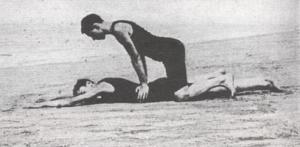Restoring Breathing
Knowledge of resuscitation of the apparently drowned is an important part of the equipment of a first-class scout, and a great many lives could have been saved had it been more general. To be effective no time must be lost in getting the apparently drowned person out of the water and getting the {287} water out of him. The Schaefer or prone method requires but one operator at a time and no waste of time in preliminaries.
When taken from the water the patient is laid on the ground face downward, arms extended above the head, face a little to one side, so as not to prevent the free passage of air. The operator kneels astride or beside the prone figure and lets his hands fall into the spaces between the short ribs. By letting the weight of the upper body fall upon his hands resting on the prone man, the air is forced out of the lungs; by relaxing the pressure, the chest cavity enlarges and air is drawn in to take the place of that forced out. By effecting this change of air–pressing and relaxing, twelve to fifteen times a minute (time it by watch at first, and then count) artificial breathing is performed. Sometimes it is necessary to work an hour or two before the flicker of an eyelid or a gasp from the patient rewards the life saver’s efforts, and then he must carefully “piece in” the breathing until natural breathing is resumed. When breathing starts, then promote circulation by rubbing the legs and body toward the heart. Do not attempt to stimulate by the throat until the patient can swallow. Give a teaspoonful of aromatic spirits of ammonia, in half a glass of water.
Remember that by laying the patient face downward fluids in the air passages will run or be forced out and the tongue will drop forward, and require no holding, always an awkward task.
Treatment After Respiration Begins
The after treatment is important. Put the patient to bed, keep quiet and warm. Always get the services of a physician as soon as possible, but do not wait for him to come. Start work instantly. The patient needs oxygen, so keep spectators away. They are robbing the man of the life-giving properties of the air. For this reason, in all but the most severe weather, it is well to work on the patient in the open.



